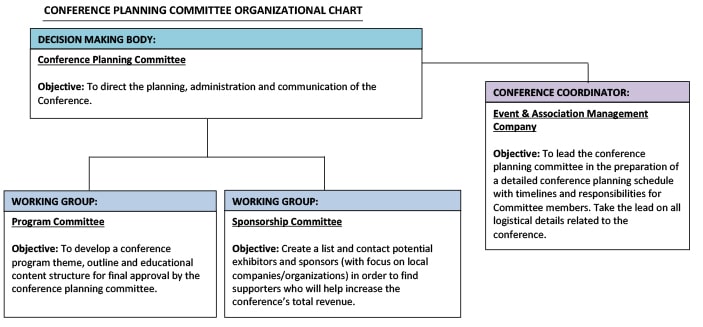Our expertise is in the logistics and the planning, but conference planning committee members are the content experts. They are the ones who help you ensure that the content is relevant, that the speakers are well selected, that the attendees will leave educated and inspired, and that all possible supporters have been contacted.
It isn’t necessary that an event manager know the ins and outs of the industry for which they are planning a conference, but it is important that they surround them self with key content experts – which are usually the association volunteers.
Depending on how the event planner’s role is defined in the contract with the association, a planner would take on responsibilities such as: managing the budget, confirming details with the venue(s), coordinating the logistics, and communications. Most final decisions however, should be made or at least vetted by the planning committee.
Based on the size of the conference, and the association’s preference, a conference planning committee may consist of two to five people. Any more than five might get overwhelming as you may start hearing too many opinions and efforts to plan regular meetings could become complicated.
Here are some suggestions on how a conference planning committee should be structured:
Everyone is equally involved in all aspects – One person should be assigned as the conference chair, but generally all committee members are encouraged to give their feedback on all aspects of the planning. At each meeting, an agenda would be shared with the committee and members would be invited to contribute when and where they can; whether it is to find speakers, suggest sponsors or help in promoting the conference. This format allows you to pull from every member’s knowledge and contacts. This works well with smaller groups (two to three members).
Each member has a specific role – If you have a larger group of volunteers on the committee, it would be more effective to assign each person a role. These roles could include: Marketing, Sponsors and Exhibitors, Volunteer Coordination, Program Development, Entertainment, Venues and Tours (this should be someone who is local to the city where your conference is being held).
Conference planning committee, supported by sub-committees – instead of having 15 people at your conference planning committee meetings, encourage the association to create sub-committees. For example, your committee could consist of:
1. A member of the executive team
2. Program lead (educational content)
3. Marketing lead
4. Sponsor/Exhibitor recruitment lead
5. Volunteer recruitment lead
Each of these members would have their own sub-committees. At the monthly or biweekly planning committee meetings, these five members would report on what was discussed at their sub-committee meetings.
Sample organization chart:

To find out more about the type of people who should be on your planning committee and how to ensure they are an effective group, you might want to read one of our articles on the subject – Your Effective Planning Committee.
Once a committee is in place, which should be at least a year before the conference, establish regular planning meetings, keep minutes and notes and use them for follow ups. The more the committee communicates with each other, the lower chances that something will be forgotten.
It is best if the committee is predominantly comprised of local members but ensure that you have at least one local team member. Planning a conference from a remote location can be challenging, so having at least one local person on board will help with confirming local supporters, finding good local venues for social events and getting the support from local members. This person is your local ambassador.
Running a conference is a lot more than you, your speakers and the audience, so figure out where you will need help and make sure you find the right people. These structures have worked for successful conferences in the past, but it is up to you and the association you were hired by, to decide what will work best for your conference.
